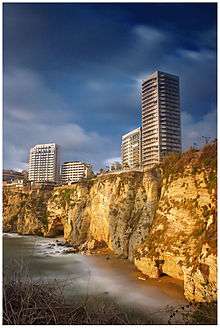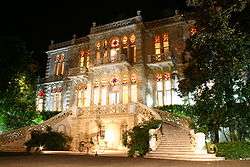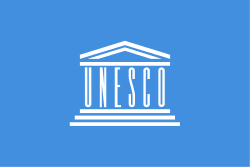Beirut
Beirut (/beɪˈruːt/ bay-ROOT;[4] Arabic: بيروت, romanized: ![]()
Beirut بيروت Beyrouth | |
|---|---|
   Beirut city photomontage | |
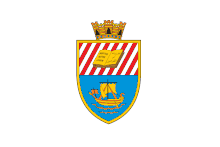 Flag  Seal | |
| Nickname(s): Paris of the East[1] | |
| Motto(s): Beirut, mother of laws (Latin: Berytus Nutrix Legum) | |
 Beirut Location of Beirut within Lebanon  Beirut Beirut (Eastern Mediterranean) 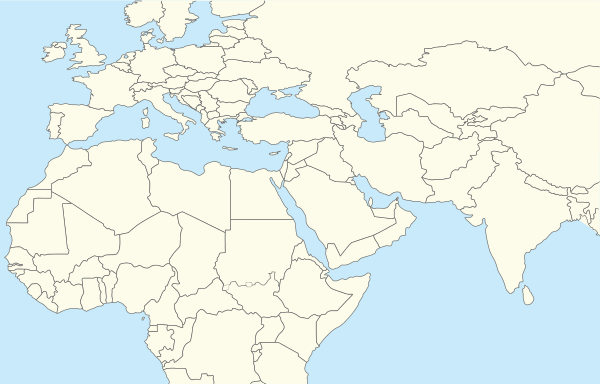 Beirut Beirut (Middle East) | |
| Coordinates: 33°53′13″N 35°30′47″E | |
| Country | |
| Governorate | Beirut |
| Government | |
| • Mayor | Jamal Itani |
| Area | |
| • Capital City | 19.8 km2 (7.6 sq mi) |
| • Metro | 67 km2 (26 sq mi) |
| Population (2014) | |
| • Capital City | c. 361,366[2] |
| • Metro | c. 2,200,000[3] |
| Demonym(s) | Beiruti |
| Time zone | UTC+2 (EET) |
| • Summer (DST) | UTC+3 (EEST) |
| Area code(s) | +961 (01) |
| ISO 3166 code | LB-BA |
| Patron Saint | Saint George |
| Website | www |
It is one of the oldest cities in the world, having been inhabited for more than 5,000 years. The first historical mention of Beirut is found in the Amarna letters from the New Kingdom of Egypt, which date to the 15th century BC.
Beirut is Lebanon's seat of government and plays a central role in the Lebanese economy, with most banks and corporations based in its Central District, Badaro, Rue Verdun, Hamra, Ryad el Soleh street, and Achrafieh. Following the destructive Lebanese Civil War, Beirut's cultural landscape underwent major reconstruction.[6][7][8] Identified and graded for accountancy, advertising, banking, finance and law, Beirut is ranked as a Beta World City by the Globalization and World Cities Research Network.[9]
Names
The English name Beirut is an early transcription of the Arabic name Bayrūt (بيروت). The same name's transcription into French is Beyrouth, which was sometimes used during Lebanon's French occupation. The Arabic name derives from Phoenician Berot or Birut (𐤁𐤓𐤕 Brt). This was a modification of the Canaanite and Phoenician word be'rot, meaning "the wells", in reference to the site's accessible water table.[10][11]. The name is first attested in the 15th century BC, when it was mentioned in three Akkadian cuneiform[11] tablets of the Amarna letters,[12] letters sent by King Ammunira of Biruta[13] to Amenhotep III or Amenhotep IV of Egypt.[14] Biruta was also mentioned in the Amarna letters from King Rib-Hadda of Byblos.[15]
The Greeks hellenised the name as Bērytós (Ancient Greek: Βηρυτός), which the Romans latinised as Berytus.[lower-alpha 1] When it attained the status of a Roman colony, it was notionally refounded and its official name was emended to Colonia Iulia Augusta Felix Berytus to include its imperial sponsors.
Before, under the Seleucid Empire, the city had been already founded and known as Laodicea in honour of the mother of Seleucus the Great. It was distinguished from several other places named in her honour by the longer names Laodicea in Phoenicia (Ancient Greek: Λαοδίκεια ἡ ἐν Φοινίκῃ, romanized: Laodíkeia hē en Phoiníkēi) or Laodicea in Canaan (Phoenician: 𐤋𐤋𐤀𐤃𐤊𐤀 𐤀𐤔 𐤁𐤊𐤍𐤏𐤍, romanized: Llʾdkʾ ʾš bknʿn).[17]
Prehistory

Prehistory
Beirut was settled more than 5,000 years ago[18] and the area had been inhabited for far longer. Several prehistoric archaeological sites have been discovered within the urban area of Beirut, revealing flint tools of sequential periods dating from the Middle Palaeolithic and Upper Paleolithic through the Neolithic to the Bronze Age.
Beirut I (Minet el-Hosn) was listed as "the town of Beirut" (French: Beyrouth ville) by Louis Burkhalter and said to be on the beach near the Orient and Bassoul hotels on the Avenue des Français in central Beirut.[19][20] The site was discovered by Lortet in 1894 and discussed by Godefroy Zumoffen in 1900.[21] The flint industry from the site was described as Mousterian and is held by the Museum of Fine Arts of Lyon.[22]
Beirut II (Umm el-Khatib) was suggested by Burkhalter to have been south of Tarik el Jedideh, where P.E. Gigues discovered a Copper Age flint industry at around 100 metres (328 feet) above sea level. The site had been built on and destroyed by 1948.[22]
Beirut III (Furn esh-Shebbak), listed as Plateau Tabet, was suggested to have been located on the left bank of the Beirut River. Burkhalter suggested that it was west of the Damascus road, although this determination has been criticised by Lorraine Copeland.[22] P. E. Gigues discovered a series of Neolithic flint tools on the surface along with the remains of a structure suggested to be a hut circle. Auguste Bergy discussed polished axes that were also found at this site, which has now completely disappeared as a result of construction and urbanisation of the area.[23]
Beirut IV (Furn esh-Shebbak, river banks) was also on the left bank of the river and on either side of the road leading eastwards from the Furn esh Shebbak police station towards the river that marked the city limits. The area was covered in red sand that represented Quaternary river terraces. The site was found by Jesuit Father Dillenseger and published by fellow Jesuits Godefroy Zumoffen,[21] Raoul Describes[24] and Auguste Bergy.[23] Collections from the site were made by Bergy, Describes and another Jesuit, Paul Bovier-Lapierre. Many Middle Paleolithic flint tools were found on the surface and in side gullies that drain into the river. They included around 50 varied bifaces accredited to the Acheulean period, some with a lustrous sheen, now held at the Museum of Lebanese Prehistory. Henri Fleisch also found an Emireh point amongst material from the site, which has now disappeared beneath buildings.
Beirut V (Nahr Beirut, Beirut River) was discovered by Dillenseger and said to be in an orchard of mulberry trees on the left bank of the river, near the river mouth, and to be close to the railway station and bridge to Tripoli. Levallois flints and bones and similar surface material were found amongst brecciated deposits.[25] The area has now been built on.[26]
Beirut VI (Patriarchate) was a site discovered while building on the property of the Lebanese Evangelical School for Girls in the Patriarchate area of Beirut. It was notable for the discovery of a finely styled Canaanean blade javelin suggested to date to the early or middle Neolithic periods of Byblos and which is held in the school library.[22]
Beirut VII, the Rivoli Cinema and Byblos Cinema sites near the Bourj in the Rue el Arz area, are two sites discovered by Lorraine Copeland and Peter Wescombe in 1964 and examined by Diana Kirkbride and Roger Saidah. One site was behind the parking lot of the Byblos Cinema and showed collapsed walls, pits, floors, charcoal, pottery and flints. The other, overlooking a cliff west of the Rivoli Cinema, was composed of three layers resting on limestone bedrock. Fragments of blades and broad flakes were recovered from the first layer of black soil, above which some Bronze Age pottery was recovered in a layer of grey soil. Pieces of Roman pottery and mosaics were found in the upper layer.[22] Middle Bronze Age tombs were found in this area, and the ancient tell of Beirut is thought to be in the Bourj area.[27]
History
The oldest settlement was on an easily defended island in the river that, however, progressively silted up and joined it to the mainland. Excavations in the downtown area have unearthed layers of Phoenician, Hellenistic, Roman, Byzantine, Arab, Crusader, and Ottoman remains.[28]
Phoenician period
The Phoenician port of Beirut was located between Rue Foch and Rue Allenby on the north coast. The port or harbour was excavated and reported on several years ago and now lies buried under the city.[29] Another suggested port or dry dock was claimed to have been discovered around 1 kilometre (0.62 miles) to the west in 2011 by a team of Lebanese archaeologists from the Directorate General of Antiquities of Lebanese University. Controversy arose on 26 June 2012 when authorisation was given by Lebanese Minister of Culture Gaby Layoun for a private company called Venus Towers Real Estate Development Company to destroy the ruins (archaeological site BEY194) in the $500 million construction project of three skyscrapers and a garden behind Hotel Monroe in downtown Beirut. Two later reports by an international committee of archaeologists appointed by Layoun, including Hanz Curver, and an expert report by Ralph Pederson, a member of the institute of Nautical Archaeology and now teaching at Marburg in Germany, dismissed the claims that the trenches were a port, on various criteria. The exact function of site BEY194 may now never be discovered, and the issue raised heated emotions and led to increased coverage on the subject of Lebanese heritage in the press.[30][31][32]
Hellenistic period
In 140 BC, the Phoenician city was destroyed by Diodotus Tryphon in his contest with Antiochus VII Sidetes for the throne of the Hellenistic Seleucid monarchy. Laodicea in Phoenicia was built upon the same site on a more conventional Hellenistic plan. Present-day Beirut overlies this ancient one, and little archaeology was carried out until after the end of the civil war in 1991. The salvage excavations after 1993 have yielded new insights in the layout and history of this Hellenistic period. Public architecture included several areas and buildings.[33]
Mid-1st-century coins from Berytus bear the head of Tyche, goddess of fortune;[34] on the reverse, the city's symbol appears: a dolphin entwines an anchor. This symbol was later taken up by the early printer Aldus Manutius in 15th century Venice. After a state of civil war and decline the Seleucid Empire faced, King Tigranes the Great of the Kingdom of Armenia conquered Beirut and placed it under effective Armenian control. However, after the Battle of Tigranocerta, Armenia forever lost their holdings in Syria and was conquered by Roman general Pompey.
Roman period
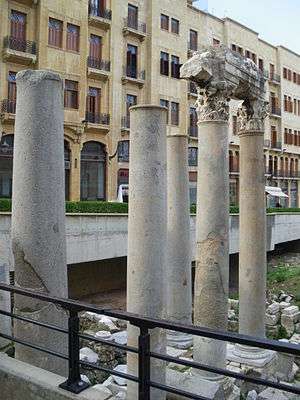
Laodicea was conquered by Pompey in 64 BC and the name Berytus was restored to it. The city was assimilated into the Roman Empire, veteran soldiers were sent there, and large building projects were undertaken.[35][36][37]
Beirut was considered the most Roman city in the eastern provinces of the Roman Empire.[38] Furthermore, the veterans of two Roman legions were established in the city of Berytus by emperor Augustus: the 5th Macedonian and the 3rd Gallic Legions.[39] Consequently, the city quickly became fully Romanized:[38] it was one of four Roman colonies (coloniae) in the Syria-Phoenicia region and the only one with full Italian rights (ius Italicum) exempting its citizens from imperial taxation.
Its territory under Claudius reached the Bekaa valley and included Heliopolis (Baalbek): it was the only mostly Latin-speaking area in the Syria-Phoenicia region, because it was settled by Roman colonists who even promoted agriculture in the fertile lands around Yammoune. From the 1st century BC, the Bekaa Valley served as a source of grain for the Roman provinces of the Levant and even for Rome itself. In 14 BC, during the reign of Herod the Great, Berytus became a colony. Its law school was widely known;[40] two of Rome's most famous jurists, Papinian and Ulpian, both natives of Phoenicia, taught there under the Severan emperors. When Justinian assembled his Pandects in the 6th century, a large part of the corpus of laws was derived from these two jurists, and in AD 533 Justinian recognised the school as one of the three official law schools of the empire. After the 551 Beirut earthquake[11][35][41] the students were transferred to Sidon.[42]
The post-war salvage excavations since 1993 have yielded new insights in the layout and history of Roman Berytus. Public architecture included several bath complexes, Colonnaded Streets, a circus and theatre;[33] residential areas were excavated in the Garden of Forgiveness, Martyrs' Square and the Beirut Souks.[43]
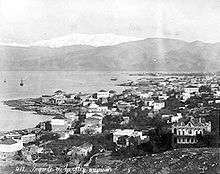
Middle Ages
Beirut was conquered by the Muslims in 635.[36][44] Prince Arslan bin al-Mundhir founded the Principality of Sin el Fil in Beirut in 759. From this principality developed the later Principality of Mount Lebanon, which was the basis for the establishment of Greater Lebanon, today's Lebanon. As a trading centre of the eastern Mediterranean, Beirut was overshadowed by Acre (in modern-day Israel) during the Middle Ages. From 1110 to 1291, the town and Lordship of Beirut was part of the Kingdom of Jerusalem. The city was taken by Saladin in 1187 and recaptured in 1197 by Henry I of Brabant as part of the German Crusade of 1197. John of Ibelin, known as the Old Lord of Beirut, was granted the lordship of the city in 1204. He rebuilt the city after its destruction by the Ayyubids and also built the House of Ibelin palace in Beirut.[44]
.jpg)
Ottoman rule

Under the Ottoman sultan Selim I (1512–1520), the Ottomans conquered Syria including present-day Lebanon. Beirut was controlled by local Druze emirs throughout the Ottoman period.[45] One of them, Fakhr-al-Din II, fortified it early in the 17th century, but the Ottomans reclaimed it in 1763.[46] With the help of Damascus, Beirut successfully broke Acre's monopoly on Syrian maritime trade and for a few years supplanted it as the main trading centre in the region. During the succeeding epoch of rebellion against Ottoman hegemony in Acre under Jezzar Pasha and Abdullah Pasha, Beirut declined to a small town with a population of about 10,000 and was an object of contention between the Ottomans, the local Druze, and the Mamluks. After Ibrahim Pasha of Egypt captured Acre in 1832,[47] Beirut began its revival.
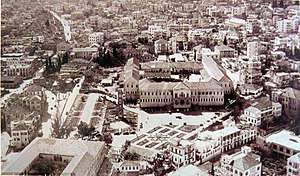
By the second half of the nineteenth century, Beirut was developing close commercial and political ties with European imperial powers, particularly France. European interests in Lebanese silk and other export products transformed the city into a major port and commercial centre. This boom in cross-regional trade allowed certain groups, such as the Sursock family, to establish trade and manufacturing empires that further strengthened Beirut's position as a key partner in the interests of imperial dynasties. Meanwhile, Ottoman power in the region continued to decline. Sectarian and religious conflicts, power vacuums, and changes in the political dynamics of the region culminated in the 1860 Lebanon conflict. Beirut became a destination for Maronite Christian refugees fleeing from the worst areas of the fighting on Mount Lebanon and in Damascus.[48] This in turn altered the religious composition of Beirut itself, sowing the seeds of future sectarian and religious troubles there and in greater Lebanon. However, Beirut was able to prosper in the meantime. This was again a product of European intervention, and also a general realisation amongst the city's residents that commerce, trade, and prosperity depended on domestic stability.[49] After petitions by the local bourgeois, the governor of Syria Vilayet Mehmed Rashid Pasha authorized the establishment of the Beirut Municipal Council,[50] the first municipality established in the Arab provinces of the Empire.[51] The council was elected by an assembly of city notables and played an instrumental role governing the city through the following decades.[50]
Vilayet of Beirut
In 1888, Beirut was made capital of a vilayet (governorate) in Syria,[52] including the sanjaks (prefectures) Latakia, Tripoli, Beirut, Acre and Bekaa.[53] By this time, Beirut had grown into a cosmopolitan city and had close links with Europe and the United States. It also became a centre of missionary activity that spawned educational institutions, such as the American University of Beirut. Provided with water from a British company and gas from a French one, silk exports to Europe came to dominate the local economy. After French engineers established a modern harbour in 1894 and a rail link across Lebanon to Damascus and Aleppo in 1907, much of the trade was carried by French ships to Marseille. French influence in the area soon exceeded that of any other European power. The 1911 Encyclopædia Britannica reported a population consisting of 36,000 Muslims, 77,000 Christians, 2,500 Jews, 400 Druze and 4,100 foreigners.[46] At the start of the 20th century, Salim Ali Salam was one of the most prominent figures in Beirut, holding numerous public positions including deputy from Beirut to the Ottoman parliament and President of the Municipality of Beirut. Given his modern way of life, the emergence of Salim Ali Salam as a public figure constituted a transformation in terms of the social development of the city.
In his 2003 book entitled Beirut and its Seven Families, Dr. Yussef Bin Ahmad Bin Ali Al Husseini says:
The seven families of Beirut are the families who bonded among each other and made the famous historical agreement with the governor of the Syrian Coast in 1351 to protect and defend the city of Beirut and its shores, and chase the invaders and stop their progress towards it.
These families are: Template:Omari
All other families of Beirut are considered to have descended from one of those seven main branches, such as Nahhas, Yanout Inkidar, Hajjal, Hamza and others who derived from the Sinno Family (p. 14).
Sinno is considered to be an old family in Beirut, descending from the Muslim Leader Tareq Bin Ziyad.
Modern era
Capital of Lebanon
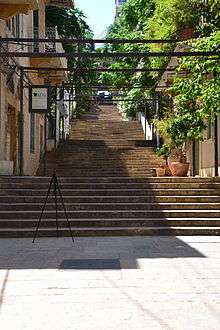

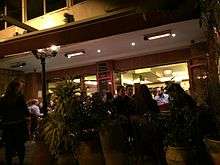
After World War I and the collapse of the Ottoman Empire, Beirut, along with the rest of Lebanon, was placed under the French Mandate. Lebanon achieved independence in 1943, and Beirut became the capital city. The city remained a regional intellectual capital, becoming a major tourist destination and a banking haven,[54][55] especially for the Persian Gulf oil boom.
This era of relative prosperity ended in 1975 when the Lebanese Civil War broke out throughout the country,[56][57] During most of the war, Beirut was divided between the Muslim west part and the Christian east.[58] The downtown area, previously the home of much of the city's commercial and cultural activity, became a no man's land known as the Green Line. Many inhabitants fled to other countries. About 60,000 people died in the first two years of the war (1975–1976), and much of the city was devastated. A particularly destructive period was the 1978 Syrian siege of Achrafiyeh, the main Christian district of Beirut. Syrian troops relentlessly shelled the eastern quarter of the city,[59] but Christian militias defeated multiple attempts by Syria's elite forces to capture the strategic area in a three-month campaign later known as the Hundred Days' War.
Another destructive chapter was the 1982 Lebanon War, during which most of West Beirut was under siege by Israeli troops. In 1983, French and US barracks were bombed, killing 241 American servicemen, 58 French servicemen, six civilians and the two suicide bombers.[60][61][62]
Since the end of the war in 1990, the people of Lebanon have been rebuilding Beirut, whose urban agglomeration was mainly constituted during war time through an anarchic urban development[63] stretching along the littoral corridor and its nearby heights. By the start of the 2006 Israel-Lebanon conflict the city had somewhat regained its status as a tourist, cultural and intellectual centre in the Middle East and as a centre for commerce, fashion, and media. The reconstruction of downtown Beirut has been largely driven by Solidere, a development company established in 1994 by Prime Minister Rafic Hariri. The city has hosted both the Asian Club Basketball Championship and the Asian Football Cup, and has hosted the Miss Europe pageant nine times: 1960–1964, 1999, 2001–2002, and 2016.
Rafic Hariri was assassinated in 2005 near the Saint George Hotel in Beirut.[64][65] A month later about one million people gathered for an opposition rally in Beirut.[66][67] The Cedar Revolution was the largest rally in Lebanon's history at that time.[68] The last Syrian troops withdrew from Beirut on 26 April 2005,[69] and the two countries established diplomatic relations on 15 October 2008.[70]
During the 2006 Lebanon War, Israeli bombardment caused damage in many parts of Beirut, especially the predominantly Shiite southern suburbs of Beirut. On 12 July 2006, the "Operation Truthful Promise" carried out by Hezbollah ended with 8 Israeli deaths and 6 injuries. In response, the IDF targeted Hezbollah's main media outlets. There were then artillery raids against targets in southern Lebanon, and the Israeli cabinet held Beirut responsible for the attacks. Then on 13 July 2006 Israel began implementing a naval and air blockade over Lebanon; during this blockade Israel bombed the runways at Beirut International Airport and the major Beirut-Damascus highway in Eastern Lebanon.[71]
In May 2008, after the government decided to disband Hezbollah's communications network (a decision it later rescinded), violent clashes broke out briefly between government allies and opposition forces, before control of the city was handed over to the Lebanese Army.[72] After this a national dialogue conference was held in Doha at the invitation of the Prince of Qatar. The conference agreed to appoint a new president of Lebanon and to establish a new national government involving all the political adversaries. As a result of the Doha Agreement, the opposition's barricades were dismantled and so were the opposition's protest camps in Martyrs' Square.[73] On 19 October 2012, a car bomb killed eight people in the Beirut's neighbourhood of Achrafiyeh, including Brigadier General Wissam al-Hassan, chief of the Intelligence Bureau of the Internal Security Forces. In addition, 78 others were wounded in the bombing.[74] It was the largest attack in the capital since 2008.[75] On 27 December 2013, a car bomb exploded in the Central District killing at least five people, including the former Lebanese ambassador to the U.S. Mohamad Chatah, and wounding 71 others.[76]
In the 12 November 2015 Beirut bombings, two suicide bombers detonated explosives outside a mosque and inside a bakery, killing 43 people and injuring 200. The Islamic State of Iraq and the Levant immediately claimed responsibility for the attacks.[77] [78]
On 4 August 2020, multiple, massive explosions in the Port of Beirut resulted in the death of at least 220 people[79] and the wounding of more than 6,000. The cause of the blast is believed to be from government-confiscated and stored ammonium nitrate. As many as 300,000 people have been left homeless by the explosions.[80] Protesters in Lebanon called on the government on 9 August 2020 for the end of the alleged negligence that resulted in the 4 August explosion.[81] On 10 August 2020, as a result of the protests, Prime Minister Hassan Diab announced his resignation.[82]
Geography

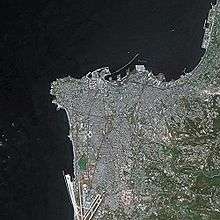
Beirut sits on a peninsula extending westward into the Mediterranean Sea.[83] It is flanked by the Lebanon Mountains and has taken on a triangular shape, largely influenced by its situation between and atop two hills: Al-Ashrafieh and Al-Musaytibah. The Beirut Governorate occupies 18 square kilometres (6.9 sq mi), and the city's metropolitan area 67 square kilometres (26 sq mi).[83] The coast is rather diverse, with rocky beaches, sandy shores and cliffs situated beside one another.
Climate
Beirut has a hot-summer Mediterranean climate (Köppen: Csa) characterised by mild days and nights, as its coastal location allows temperatures to be moderated by the sea. Autumn and spring are warm, but short. Winter is mild and rainy. Summer is prolonged, hot and muggy. The prevailing wind during the afternoon and evening is from the west (onshore, blowing in from the Mediterranean); at night it reverses to offshore, blowing from the land out to sea.
The average annual rainfall is 825 millimetres (32.5 in), with the large majority of it falling from October to April. Much of the autumn and spring rain falls in heavy downpours on a limited number of days, but in winter it is spread more evenly over many days. Summer receives very little rainfall, if any. Snow is rare, except in the mountainous eastern suburbs, where snowfall occurs due to the region's high altitudes. Hail (which can often be heavy) occurs a few times per year, mostly during winter.
| Climate data for Beirut International Airport | |||||||||||||
|---|---|---|---|---|---|---|---|---|---|---|---|---|---|
| Month | Jan | Feb | Mar | Apr | May | Jun | Jul | Aug | Sep | Oct | Nov | Dec | Year |
| Record high °C (°F) | 27.9 (82.2) |
30.5 (86.9) |
36.6 (97.9) |
39.3 (102.7) |
39.0 (102.2) |
40.0 (104.0) |
40.4 (104.7) |
39.5 (103.1) |
37.5 (99.5) |
37.0 (98.6) |
33.1 (91.6) |
30.0 (86.0) |
40.4 (104.7) |
| Average high °C (°F) | 17.4 (63.3) |
17.5 (63.5) |
19.6 (67.3) |
22.6 (72.7) |
25.4 (77.7) |
27.9 (82.2) |
30.0 (86.0) |
30.7 (87.3) |
29.8 (85.6) |
27.5 (81.5) |
23.2 (73.8) |
19.4 (66.9) |
24.3 (75.7) |
| Daily mean °C (°F) | 14.0 (57.2) |
14.0 (57.2) |
16.0 (60.8) |
18.7 (65.7) |
21.7 (71.1) |
24.9 (76.8) |
27.1 (80.8) |
27.8 (82.0) |
26.8 (80.2) |
24.1 (75.4) |
19.5 (67.1) |
15.8 (60.4) |
20.9 (69.6) |
| Average low °C (°F) | 11.2 (52.2) |
11.0 (51.8) |
12.6 (54.7) |
15.2 (59.4) |
18.2 (64.8) |
21.6 (70.9) |
24.0 (75.2) |
24.8 (76.6) |
23.7 (74.7) |
21.0 (69.8) |
16.3 (61.3) |
12.9 (55.2) |
17.7 (63.9) |
| Record low °C (°F) | 0.8 (33.4) |
3.0 (37.4) |
0.2 (32.4) |
7.6 (45.7) |
10.0 (50.0) |
15.0 (59.0) |
18.0 (64.4) |
19.0 (66.2) |
17.0 (62.6) |
11.1 (52.0) |
7.0 (44.6) |
4.6 (40.3) |
0.2 (32.4) |
| Average precipitation mm (inches) | 154 (6.1) |
127 (5.0) |
84 (3.3) |
31 (1.2) |
11 (0.4) |
1 (0.0) |
0.3 (0.01) |
0 (0) |
5 (0.2) |
60 (2.4) |
115 (4.5) |
141 (5.6) |
730 (28.7) |
| Average rainy days | 12 | 10 | 8 | 5 | 2 | 2 | 0.04 | 0.1 | 1 | 4 | 7 | 11 | 62 |
| Average relative humidity (%) | 64 | 64 | 64 | 66 | 70 | 71 | 72 | 71 | 65 | 62 | 60 | 63 | 66 |
| Mean monthly sunshine hours | 131 | 143 | 191 | 243 | 310 | 348 | 360 | 334 | 288 | 245 | 200 | 147 | 2,940 |
| Source 1: Pogodaiklimat.ru[84] | |||||||||||||
| Source 2: Danish Meteorological Institute (sun 1931–1960)[85] | |||||||||||||
| Jan | Feb | Mar | Apr | May | Jun | Jul | Aug | Sep | Oct | Nov | Dec |
|---|---|---|---|---|---|---|---|---|---|---|---|
| 18.5 °C (65.3 °F) | 17.5 °C (63.5 °F) | 17.5 °C (63.5 °F) | 18.5 °C (65.3 °F) | 21.3 °C (70.3 °F) | 24.9 °C (76.8 °F) | 27.5 °C (81.5 °F) | 28.5 °C (83.3 °F) | 28.1 °C (82.6 °F) | 26.0 °C (78.8 °F) | 22.6 °C (72.7 °F) | 20.1 °C (68.2 °F) |
Environmental issues
Lebanon, especially Beirut and its suburbs, suffered a massive garbage crisis, mainly from July 2015 up to March 2016. The issue began when authorities shut down the main landfill site originally used for Beirut's garbage south-east of the city and failed to provide any alternative solutions for months. As a result, garbage mounted in the streets in Greater Beirut and caused protests to erupt, which sometimes invoked police action. This problem was commonly blamed on the country's political situation. This garbage crisis birthed a movement called "You Stink" which was directed at the country's politicians. In March 2016, the government finally came up with a so-called temporary solution to establish two new landfills East and South of the city to store the garbage, while several municipalities across the country, in an unprecedented move, began recycling and managing waste more efficiently, building waste-management facilities and relying on themselves rather than the central government. Moreover, Beirut has a lack of green areas with just two main public gardens (sanayeh and horch Beirut). In fact, concrete roofs cover 80% of the capital area.[87]
Quarters and sectors

Beirut is divided into 12 quarters (quartiers):[88]
- Achrafieh
- Dar Mreisse
- Bachoura
- Mazraa (with the neighbourhood Badaro)
- Medawar (with the neighbourhood Mar Mikhaël)
- Minet El Hosn
- Moussaitbeh (with Ramlet al-Baida)
- Port
- Ras Beirut
- Remeil
- Saifi
- Zuqaq al-Blat
These quarters are divided into 59 sectors (secteurs).[89]
Badaro is an edgy, bohemian style neighbourhood, within the green district of Beirut (secteur du parc) which also include the Beirut Hippodrome and the Beirut Pine Forest and the French ambassador's Pine Residence. It is one of Beirut's favourite hip nightlife destination.
Two of the twelve official Palestinian refugee camps in Lebanon are located in the southern suburbs of Beirut: Bourj el-Barajneh and Shatila. There is also one within its municipal boundaries: Mar Elias.[90] Of the 15 unregistered or unofficial refugee camps, Sabra, which lies adjacent to Shatila, is also located in southern Beirut[91] and was the scene of a massacre during the civil war
People in Lebanon often use different names for the same geographic locations, and few people rely on official, government-provided street numbers. Instead, historic and commercial landmarks are more common.
Demographics
No population census has been taken in Lebanon since 1932,[92] but estimates of Beirut's population range from as low as 938,940[93] through 1,303,129[94] to as high as 2,200,000 as part of Greater Beirut.[3][95]
Religion
Beirut is one of the most cosmopolitan and religiously diverse cities of Lebanon and all of the Middle East.[96] The city boasts significant Muslim and Christian communities. In Beirut there are 18 recognised religious groups.[97] At the end of the civil war the Copts became another recognised confession, bringing the total number to eighteen. The original seventeen included four Muslim sects: Shi'a, Sunni, 'Alawi, and Druze; Twelve Christian sects: Maronite Catholics, Greek Orthodox, Melkite Catholics, Protestant Evangelicals, and other Christian denominations non-native to Lebanon like Armenian Orthodox, Armenian Catholics, Assyrians (Syriac Orthodox, Syriac Catholic, Church of the East, Chaldean Catholic), Copts; and Jews (very few remain in Lebanon today, but children of Lebanese Jewish parents may register as citizens at Lebanese Embassies.[98]) Briefly, Christians are 42% of Beirut, Muslims 52%, 5% Druze,1% others.
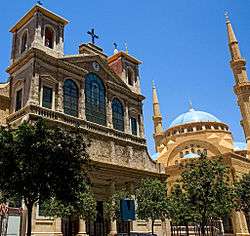 Church of Saint George Maronite and Mohammad Al-Amin Mosque coexist side by side in Downtown Beirut
Church of Saint George Maronite and Mohammad Al-Amin Mosque coexist side by side in Downtown Beirut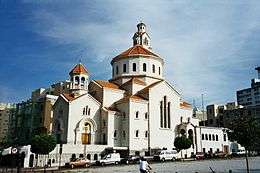 Cathedral of St Elias and St Gregory the Illuminator in Downtown Beirut
Cathedral of St Elias and St Gregory the Illuminator in Downtown Beirut Cathedral of St. George's Greek Orthodox in Downtown Beirut
Cathedral of St. George's Greek Orthodox in Downtown Beirut
Family matters such as marriage, divorce and inheritance are still handled by the religious authorities representing a person's faith (the Ottoman "millet" system). Calls for civil marriage are unanimously rejected by the religious authorities, but civil marriages held in another country are recognised by Lebanese civil authorities.
Before the civil war the neighbourhoods of Beirut were fairly heterogeneous, but they became largely segregated by religion since the conflict.[99] East Beirut has a mainly Christian population with a small Muslim minority, while West Beirut has a Sunni Muslim majority with small minorities of Shia, Christians and Druze. Since the end of the civil war, East and West Beirut have begun to see an increase in Muslims and Christians moving into each half. The southern suburbs are populated largely by Shia Muslims, while the eastern and northern suburbs are largely Christian.
The city is also home to a small number of Latin Rite Roman Catholics in the form of an apostolic vicariate with Archbishop Paul Dahdah, OCD, as the apostolic vicar.
Beirut Central District
The Beirut Central District (BCD) or Centre Ville is the name given to Beirut's historical and geographical core by "Solidere", the "vibrant financial, commercial, and administrative hub of the country."[100] It is an area thousands of years old, traditionally a focus of business, finance, culture and leisure. Its reconstruction constitutes one of the most ambitious contemporary urban developments.[101] Due to the devastation incurred on the city centre from the Lebanese Civil War, the Beirut Central District underwent a thorough reconstruction and development plan that gave it back its cultural and economic position in the region. Ever since, Beirut Central District has evolved into an integrated business and commercial environment and the focus of the financial activity in the region. That evolution was accompanied with the relocation of international organisations, reoccupation of civic and government buildings, expansion of financial activities, and establishment of regional headquarters and global firms in the city centre.[102]
Assessment of the demand for build-up space in the BCD has been done in reference to a number of macro-economic, demographic, and urban planning considerations at a time of marked need for new activity poles in the city, such as Souks, financial, cultural and recreational centres.[103] The district's total area is 4,690,000 square metres (50,482,740 square feet), the majority of which is dedicated to residential space (1,924,000 square metres or 20,709,764 square feet).[104] The Beirut Central District contains over 60 gardens, squares and open spaces. These spaces comprise landscaped streets, gardens, historical squares, pedestrian areas and sea promenades thus totalling to an area of 96 acres (39 ha) of open spaces.
The central district is Lebanon's prime location for shopping, entertainment, and dining. There are over 100 cafes, restaurants, pubs and nightclubs open in the Beirut Central District, and over 350 retail outlets distributed along its streets and quarters. Beirut Souks alone are home to over 200 stores and a handful of restaurants and cafes. Beirut Souks are the Central District's old medieval market, recently renovated along with the original Hellenistic street grid that characterised the old souks and the area's historical landmarks along long vaulted shopping alleys and arcades.[105] Solidere, the company responsible for the reconstruction and renovation of the district, organises music and entertainment events all throughout the year like the Beirut Marathon, Fête de la Musique, Beirut Jazz Festival.
However, the means of urban development in this particular area of the city was subject to much criticism and controversy. Rafic Hariri, who would later become prime minister, was the majority stakeholder of the company, which raises concerns of conflict of interest in the context of a public-private partnership.[106] Many of the expropriations that have made the project possible have been made at undervalued land rates, and partly paid in company share. Strict urbanisation laws were put in order to oblige people to sell and not renovate themselves.[107] Today, Solidere acts as a de facto municipality, thus this quarter of the city is effectively privatised. It is for example forbidden to ride bikes on Zeituna Bay, a marina where many restaurants are located, and these laws are enforced by private security guards not national or municipal police.
The project was also criticised for destroying some of the city's architectural and cultural heritage. "Among the hundreds of destroyed buildings were "the last Ottoman and medieval remains in Beirut" wrote American University of Beirut professor Nabil Beyhum in the Journal The Beirut Review in 1992. Much of the damage had been done through unapproved demolitions in the 1980s and early 1990s, bringing down "some of the capital's most significant buildings and structures," wrote UCLA professor Saree Makdisi in the journal, Critical Inquiry, in 1997.".[108] Moreover, many of the traditional privately owned shops in the Beirut Downtown were replaced by luxury outlets and high-end restaurants that only few people could afford. And most of public spaces promised by Solidere since the start of the reconstruction, such as "The Garden of Forgiveness", a central park, and an archaeological museum, remain unfinished until today, putting into question the actual benefit of the project to the population.[108]
Finally, the actual success of the project has recently been in doubt, given that large quarters of the BCD are today empty, due to strong military presence, the Nejmeh Square where the parliament is located is most frequently completely deserted, and the business located there have mostly moved.[109]
Economy

Beirut's economy is service-oriented with the main growth sectors being banking and tourism.
In an area dominated by authoritarian or militarist regimes, the Lebanese capital was generally regarded as a haven of libertarianism, though a precarious one. With its seaport and airport—coupled with Lebanon's free economic and foreign exchange system, solid gold-backed currency, banking-secrecy law, and favourable interest rates—Beirut became an established banking centre for Arab wealth, much of which was invested in construction, commercial enterprise, and industry (mostly the manufacture of textiles and shoes, food processing, and printing).[110] The economy of Beirut is diverse, including publishing, banking, trade and various industries. During that period, Beirut was the region's financial services center. At the onset of the oil boom starting in the 1960s, Lebanon-based banks were the main recipients of the region's petrodollars.[111]
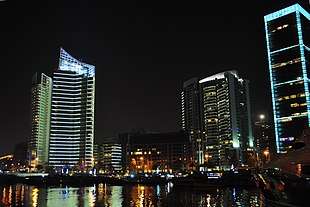
Beirut is the focal point of the Economy of Lebanon. The capital hosts the headquarters of Banque du Liban, Lebanon's central bank, the Beirut Stock Exchange, the head office of Lebanon's flag-carrier Middle East Airlines, the United Nations Economic and Social Commission for Western Asia, the Union of Arab Banks, and the Union of Arab Stock Exchanges.[112]
Banking and finance
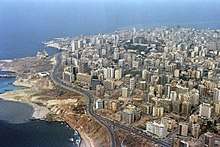
The Banking System is the backbone of the local economy with a balance sheet of $152 billion at the end of 2012, nearing 3.5 times the GDP estimated at $43 billion by the IMF.[113] Bank deposits also increased in 2012 by 8% to 125 billion dollars, 82 percent of the sector's assets. "Banks are still attracting deposits because the interest rates offered are higher than the ones in Europe and the United States", says Marwan Mikhael, head of research at BLOM Bank.[114]
Beirut's foreign reserves were still close to an all-time high when they reached $32.5 billion in 2011 and analysts say that the Central Bank can cover nearly 80 percent of the Lebanese currency in the market. This means that the Central Bank can easily cope with any unforeseen crisis in the future thanks to the massive foreign currency reserves.[115]
The Lebanese banking system is endowed with several characteristics that promote the role of Beirut as a regional financial centre, in terms of ensuring protection for foreign capital and earnings. The Lebanese currency is fully convertible and can be exchanged freely with any other currency. Moreover, no restrictions are put on the free flow of capital and earnings into and out of the Lebanese economy. The passing of the banking secrecy law on 3 September 1956, subjected all banks established in Lebanon as well as foreign banks' branches to the "secret of the profession". Both article 16 of law No. 282 dated 30 December 1993 and article 12 of decree No. 5451 dated 26 August 1994, offer exemptions from income tax on all interest and revenues earned on all types of accounts opened in Lebanese banks. On the first of April 1975, decree No. 29 established a free banking zone by granting the Lebanese government the right to exempt non-residents' deposits and liabilities in foreign currency from: the income tax on interest earned, the required reserves imposed by the Banque Du Liban by virtue of article 76 of the Code of Money and Credit, the premium of deposit guarantee imposed on bank deposits to the profit of the National Deposit Guarantee Institution.[116]
Tourism
The tourism industry in Beirut has been historically important to the local economy and remains to this day to be a major source of revenue for the city, and Lebanon in general. Before the Lebanese Civil War, Beirut was widely regarded as the "Paris of the Middle East,"[117] often cited as a financial and business hub where visitors could experience the Levantine Mediterranean culture. Beirut's diverse atmosphere and ancient history make it an important destination which is slowly rebuilding itself after continued turmoil. However, in recent times, certain countries, such as the United States, have frequently placed Lebanon, and Beirut in particular, on their travel warnings lists due to the many car bombings and orchestrated acts of political violence.[118][119][120]
.jpg)
According to the 2012 tourist statistics, 34% of the tourists in Beirut came from states within the Arab League, 33% came from European countries (mainly France, Germany, and Britain), and 16% from the Americas (about half of which are from the United States).[121]
The largely pedestrianised Beirut Central District is the core of the Beirut tourism scene. The district is a cluster of stone-façade buildings lining arcaded streets and radial alleyways. The architecture of the area is a mix of French Architecture and Venetian Gothic architecture mixed with Arabesque and Ottoman Architecture. The district contains numerous old mosques and crusader churches, as well as uncovered remnants and ruins of the Roman era. The District contains dozens of restaurants, cafes and pubs, as well as a wide range of shopping stores mainly in Beirut Souks. High-rise hotels and towers line the district's New Waterfront, marina and seaside promenade.
Another popular tourist destination in Beirut is the Corniche Beirut, a 4.8 km (3 mi) pedestrian promenade that encircles the capital's seafront from the Saint George Bay in the north all the way to Avenue de Paris and Avenue General de Gaulle south of the city. The corniche reaches its maximum height above sea level at Raouché, a high-rise residential neighbourhood rising over a giant white limestone cliff and facing the recognisable off-shore Raouché Rocks.
Badaro is one of Beirut's most appealing neighbourhoods, a lovely place to stroll during daytime and a destination for going out in the evening. Badaro is within Beirut's green district with a 75-acre (30-hectare) public park (The Beirut Pine forest) and a 50-acre (20-hectare) hippodrome. It is a neighbourhood on a very human scale with small groceries around every corner. The neighbourhood residents, a mix of old impoverished Christian bourgeoisie, bohemian style people in their 30s and well-established urban professionals, are loyal to local bakery and pastry shops. Because of the blossoming café and bar scene it has become lately a hip destination for Beirut's young and restless but old Beirutis remember that Badaro was already Beirut's version of the Village in the swinging sixties. Groceries and eateries can be found on almost every street of the area. There are dozens of restaurants, pubs and footpath cafés of virtually every style. Badaro "Village" thrives on local residents, day-trippers and hipsters from all over Beirut, office employees and many expatriates.
Hamra Street is a long cobblestone street connecting the Beirut Central District with the coastal Raouche area. The street is a large concentration of shopping stores, boutiques, restaurants, banks, street vendors, footpath cafes, newspaper kiosks, and a booming nightlife spurred by students from the neighbouring American University of Beirut. The AUB campus is another popular visitor destination, composed of a cluster of 19th century red-roofed buildings dispersed on a wooded hillside overlooking the Mediterranean.
Gemmayzeh is Beirut's artistic Bohemian quarter, full of narrow streets and historic buildings from the French era. It is located East of the Beirut Central District, bordering the Saifi Village. The neighbourhood is well known for its trendy bars and pubs, cafes, restaurants and lounges; most are directly located on Rue Gouraud, the main thoroughfare that cuts through the middle of the district. Travel + Leisure magazine called Gemmayzeh "SoHo by the Sea," due to its colourful and chic cafés amid 1950s apartment buildings and hole-in-the-wall shops.[122]
.jpg)
Beirut is a destination for tourists from both the Arab world and West.[123] In Travel + Leisure magazine's World Best Awards 2006, it was ranked 9th best city in the world.[124] That list was voted upon shortly before the 2006 Lebanon War broke out, but in 2008 The Guardian listed Beirut as one of its top ten cities in the world.[125] The New York Times ranked it at number one on its "44 places to go" list of 2009.[126] 2011 MasterCard Index revealed that Beirut had the second-highest visitor spending levels in the Middle East and Africa, totalling $6.5 billion.[127] Beirut was chosen in 2012 by Condé Nast Traveller as the best city in the Middle East, beating Tel Aviv and Dubai.[128]
Many of the tourists are returning Lebanese expatriates, but many are from Western countries. Approximately 3 million visitors visited in 2010; the previous record was 1.4 million in 1974.[129]
Like other forms of tourism, medical tourism in Lebanon is on the rise recently. Although visitors from neighbouring Arab nations make up the bulk of medical tourism patients here due to its proximity, Beirut is strongly trying to woo more Southern Europeans, Asians and North Americans to its land. Its Agency for Investment Development in Lebanon reports that growth in the medical tourism industry is growing by up to 30% a year since 2009. The country's tourism ministry is working closely with the medical sector and top-class hotels to create an organised, quality medical destination.[130] Major hotel and spa chains work with local clinics, travel agencies and the tourism ministry to create comprehensive healthcare and recuperation packages for foreign visitors. The government is highly involved in this industry and strives to make the process as easy as possible.[131] Cosmetic surgery is a major component of medical tourism in Lebanon. Most of the foreign patients come for routine operations like plastic surgery, dental or eye surgery, and Beirut's hospitals are also capable of performing specialised procedures such as internal bypass surgery and other technical treatments. Its top clinics and hospitals like Sahel General are equipped to handle the full range of surgical procedures. Beirut-based Clemenceau Medical Center (CMC), affiliated with Johns Hopkins International, was ranked one of the world's top ten best hospitals for medical tourism in 2012.[132]
Government
Beirut is the capital of Lebanon and its seat of government.[133] The Lebanese Parliament,[134] all the Ministries and most of the public administrations, embassies and consulates are there.[135] Beirut Governorate is one of eight mohafazat (plural of mohafazah, or governorate).
| Name | Took office | Left office | |
|---|---|---|---|
| 1 | Kamel Hamieh | 1936 | 1941 |
| 2 | Nicholas Rizk | 1946 | 1952 |
| 3 | George Assi | 1952 | 1956 |
| 4 | Bachour Haddad | 1956 | 1958 |
| 5 | Philip Boulos | 1959 | 1960 |
| 6 | Emile Yanni | 1960 | 1967 |
| 7 | Shafic Bou Haydar | 1967 | 1977 |
| 8 | Mitri El Nammar | 1977 | 1987 |
| 9 | George Smaha | 1987 | 1991 |
| 10 | Nayef El Malouf | 1992 | 1995 |
| 11 | Nicholas Saba | 1995 | 1999 |
| 12 | Jacob Sarraf | 1999 | 2005 |
| 13 | Nassif Kaloush | 2005 | 2008 |
| 14 | Rachid Ammoury Maalouf | 2008 | 2015 |
| 15 | Jamal Itani | 2016 | Present |
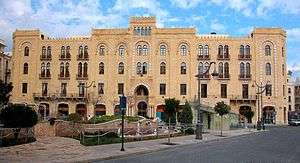 Facade of the Beirut City Hall
Facade of the Beirut City Hall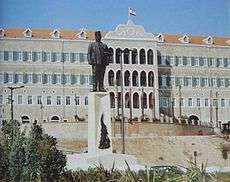 The Grand Serail
The Grand Serail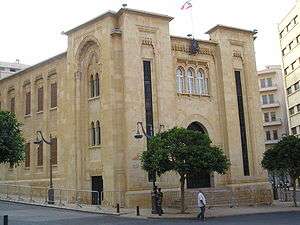 Lebanese Parliament
Lebanese Parliament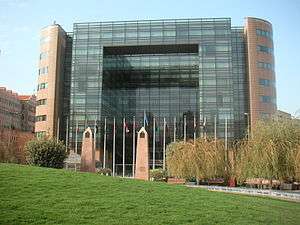 United Nations Lebanon headquarters
United Nations Lebanon headquarters
International organisations
The city is home to numerous international organisations. The United Nations Economic and Social Commission for Western Asia (ESCWA) is headquartered in downtown Beirut,[136][137] The Arab Air Carriers Organization (AACO),[138] the Union of Arab Banks[139] and the Union of Arab Stock Exchanges[140] are also headquartered in the city. The International Labour Organization (ILO)[141] and UNESCO (United Nations Educational, Scientific and Cultural Organization)[142] both have regional offices in Beirut covering the Arab world.
Education
Higher education throughout Lebanon is provided by universities, colleges and technical and vocational institutes.
The American University of Beirut and Université Saint-Joseph (USJ), are the oldest respectively English medium and French medium universities in the country.
The Lebanese University is the only public institution for higher education in Beirut.[143] Beirut is also home to the Lebanese American University (LAU), which is also, together with many of its programs, accredited by US bodies and considered lately one of the top universities in the Middle East.[144][145][146][147][148] Beirut is also home to the American University of Science and Technology (AUST), University of Balamand, École Supérieure des Affaires (ESA), Beirut Arab University (BAU), Haigazian University (HU), Lebanese International University (LIU), as well as the Notre Dame University – Louaize (NDU), Université La Sagesse (ULS). Notre Dame University (NDU)'s degrees are becoming more and more valuable with time. NDU received its accreditation from NIASC in 2015.
The Directorate General of Higher Education is responsible for managing the university colleges, university institutes and universities in Beirut and nationwide.[143]
Among the private secondary schools in Beirut are, College Saint Joseph Antoura, Lycee Abdel Kader, Grand Lycée Franco-Libanais, Lycée Franco-Libanais Verdun, American Community School, International College, Collège Notre-Dame de Jamhour, College Melkart, Carmel Saint-Joseph, Collège Louise Wegmann, Rawdah High School, Saint Mary's Orthodox College,[149] Collège Notre Dame de Nazareth, Collège du Sacré-Coeur Gemmayzé, Collège Protestant Français, Armenian Evangelical Central High School, German School of Beirut, and the Armenian Hamazkayin Arslanian College.
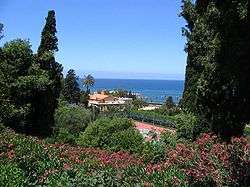 AUB established in 1866 by the American Board of Commissioners for Foreign Missions
AUB established in 1866 by the American Board of Commissioners for Foreign Missions Saint Joseph University, or Université Saint-Joseph, founded by the Jesuits in 1875
Saint Joseph University, or Université Saint-Joseph, founded by the Jesuits in 1875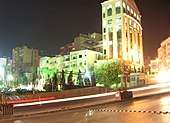 American University of Science and Technology, established in Beirut in 1989
American University of Science and Technology, established in Beirut in 1989 Haigazian University was founded in 1955 by the Armenian Evangelical community
Haigazian University was founded in 1955 by the Armenian Evangelical community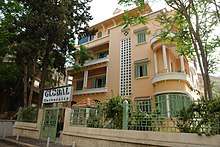 Global University in Beirut
Global University in Beirut École supérieure des affaires, founded in 1996 as a joint co-operation between the Paris Chamber of Commerce (Chambre de Commerce et d'Industrie de Paris) and the Bank of Lebanon
École supérieure des affaires, founded in 1996 as a joint co-operation between the Paris Chamber of Commerce (Chambre de Commerce et d'Industrie de Paris) and the Bank of Lebanon
Transportation
The city's renovated airport is the Rafic Hariri International Airport, located in the southern suburbs. The Port of Beirut, one of the largest and most commercial in the eastern Mediterranean, is another port of entry. As a final destination, Lebanon can be reached by ferry from Cyprus via the nearby city of Jounieh or by road from Damascus via the Beqaa valley in the east.[150]
Beirut has frequent bus connections to other cities in Lebanon and major cities in Syria such as Homs and its capital Damascus. There are a number of different companies providing public transport in Lebanon. The publicly owned buses are managed by Office des Chemins de Fer et des Transports en Commun (OCFTC – "Railway and Public Transportation Authority"). Buses for northern destinations and Syria leave from Charles Helou Station.[151]
The ministry of transport and public works purchased an extra 250 intra and inter-buses in 2012 to better serve regions outside the capital as well as congestion-choked Beirut, hoping to lessen the use of private cars.
Beirut has also private buses that are provided by the Lebanese Commuting Company.
In 2017, Beirut introduced a bike sharing service in certain areas of the city.
Culture

The culture of Beirut has evolved under the influence of many different peoples and civilisations, such as Greeks, Romans, Arabs, Ottoman Turks and French. The law school in downtown Beirut was one of the world's earliest and was considered to be a leading centre of legal studies in the Eastern Roman Empire.
Beirut hosted the Francophonie and Arab League summits in 2002, and in 2007 it hosted the ceremony for the Prix Albert Londres,[152][153] which rewards outstanding francophone journalists every year. The city also hosted the Jeux de la Francophonie in 2009.[154][155] In the same year it was proclaimed World Book Capital by UNESCO.[156]
Beirut has also been called the "party capital of the Arab world".[157] Rue Monnot has an international reputation among clubbers,[158] and Rue Gouraud in districts such as Gemmayze and Mar Mikhael have emerged as new hotspots for bar patrons and clubbers, as well as "The Alleyway" in Hamra Street.
Museums

The National Museum of Beirut is the principal museum of archaeology in Lebanon. It has about 1,300 exhibits ranging in date from prehistoric times to the medieval Mamluk period.[159] The Archaeological Museum of the American University of Beirut is the third oldest museum in the Middle East, exhibiting a wide range of artefacts from Lebanon and neighbouring countries.[160] Sursock Museum was built by the illustrious Sursock family at the end of the 19th century as a private villa for Nicolas Sursock, and then donated to the Lebanese state upon his death. It now houses Beirut's most influential and popular art museum. The permanent collection shows a set of Japanese engravings, numerous works of Islamic art and classic Italian paintings, while temporary exhibitions are also shown throughout the year. The Robert Mouawad Private Museum near Beirut's Grand Serail exhibits Henri Pharaon's private collection of archaeology and antiques.[161][162]
Planet Discovery is a children's science museum with interactive experiments, exhibitions, performances, workshops and awareness competitions.[163] The Saint Joseph University opened the Museum of Lebanese Prehistory in 2000, the first prehistory museum in the Arabic Middle East, displaying bones, stone tools and neolithic pottery collected by Jesuits.[164]
In October 2013, Mim Museum, a private mineral museum, opened its doors to the public. It has on display some 2000 minerals from more than 70 countries. Mim museum's collection is considered to be one of the world's paramount private collection for the variety and quality of its minerals.[165][166] A didactic circuit, accompanied by screens showing films and scientific applications of mineralogy, will reveal a world of unsuspected marvels—priceless both from an aesthetic and scientific point of view. Mimodactylus libanensis "mimo", the fossil of a pterodactyl is featured in a special wing. This one-of-a-kind complete specimen in the Middle-East was found in Lebanon. It is promoted by means of state-of-the-art modern techniques: a hologram, an auto-stereoscopic movie, a full-scale reconstitution and a game "fly with mimo" – an entertainment that delights children and adults. Moreover, Mim hosts a thematic exhibition of 200 marine fossils. "Fish’n’Stone" was organised with the collaboration of Mémoire du Temps. Known throughout the world, those fossils were quarried in the Lebanese mountains. The history of the fossil formation is shown through an animation that submerses you in the marine life – a time capsule that takes you in a journey to some 100 million of years ago.
Tourism
Beirut was named the top place to visit by The New York Times in 2009,[126] and as one of the ten liveliest cities in the world by Lonely Planet in the same year.[167] According to a 2010 study by the American global consulting firm Mercer comparing high-end items such as upscale residential areas and entertainment venues, Beirut was ranked as the 4th most expensive city in the Middle East and 15th among the Upper Middle Income Countries included in the survey.[168] Beirut came in first place regionally and 10th place internationally in a 2010 study by "EuroCost International" about the rental markets for high quality housing.[169][170]
The 2011 MasterCard Index revealed that Beirut had the second-highest visitor spending levels in the Middle East and Africa, totalling $6.5 billion.[127] Beirut was chosen in 2012 by Condé Nast Traveller as the best city in the Middle East.[128] In 2013, Condé Nast Traveller ranked Beirut in the top 20 best cities in the world.[171]
On 7 December 2014, Beirut was selected to be among the New 7 Wonders of Cities, along with Doha, Durban, La Paz, Havana, Kuala Lumpur and Vigan.[172] The campaign was held by New 7 Wonders.[173]
In 2016, Yahoo listed Beirut as the best international city for food.[174] Travel and Leisure ranked Beirut in the top 15 World's best cities.[175]
It was voted the must-visit city for the year 2019 by World Tourists.
Media
Beirut is a main centre for the television, radio stations, newspaper, and book publishing industries.
Television stations based in Beirut include Télé Liban, LBC, ÓTV (Orange TV), MTV Lebanon, Tele Lumiere (Catholic TV), Future TV, New TV, NBN, ANB and Saudi TV 1 on 33 UHF and MBC 1, MBC 4, MBC Action, Fox, Al Jazeera, Rotana, OSN First, OSN News, Al Yawm and Arabic Series Channel on 45 UHF.
Radio Stations include Mix FM Lebanon, Virgin Radio Lebanon, Radio One Lebanon, Sawt el Ghad, RLL, Jaras Scoop, NRJ Lebanon...
Newspapers include An-Nahar, Al Joumhouria, As-Safir, Al Mustaqbal, Al-Akhbar, Al-Balad, Ad-Diyar, Al Anwar, Al Sharq.
Newspapers and magazines published in French include L'Orient Le Jour (since 1970), La Revue Du Liban, Al Balad-French Version, Al Intiqad, Magazine L'Hebdo and La Commerce Du Levant.
English newspapers published in Beirut are The Daily Star, Executive Magazine (weekly), Beirut Online, Beirut Times (weekly) and Monday Morning.
Sports
The Lebanese capital hosted the Mediterranean Games in 1959, FIBA Asia Champions Cup in 1999, 2000, 2012, the AFC Asian Cup in 2000, and the FIBA Asia Cup in 2010. Beirut was the host city for the 6th Annual Games of the Jeux de la Francophonie in 2009. Beirut also hosted the Pan Arab Games in 1957, 1997, and did so again in 2015. In 2017, Beirut also hosted the 2017 FIBA Asia Cup.
Beirut, with Sidon and Tripoli, hosted the 2000 AFC Asian Cup.[176][177] There are two stadiums in the city, Camille Chamoun Sports City Stadium and Beirut Municipal Stadium.
Basketball is the most popular sport in Lebanon. Currently, 4 Beirut teams play in Lebanese Basketball League: Hekmeh, Sporting Al Riyadi Beirut, Homenetmen Beirut and Beirut.
Other sports events in Beirut include the annual Beirut Marathon, hip ball, weekly horse racing at the Beirut Hippodrome, and golf and tennis tournaments that take place at Golf Club of Lebanon. Three out of the five teams in the Lebanese rugby league championship are based in Beirut. Lebanon men's national ice hockey team plays out of Montreal, in Canada.
Art and fashion

There are hundreds of art galleries in Beirut and its suburbs. Every year hundreds of fine art students graduate from universities and institutions. Artist workshops exist all over Lebanon. The inauguration of the Beirut Art Center, a non-profit association, space and platform dedicated to contemporary art in Lebanon,[178] in the Mkalles suburb of Beirut added to the number of exhibition spaces available in the city, with a screening and performance room, mediatheque, book store, café and terrace. Adjacent to the latter is the Ashkal Alwan Home Workspace, a venue hosting cultural events and educational programs.
A number of international fashion designers have displayed their work in big fashion shows.[179] Most major fashion labels have shops in Beirut's shopping districts, and the city is home to a number of local fashion designers, some of whom like Elie Saab, Yara Farhat, Reem Acra, Zuhair Murad, Georges Chakra, Georges Hobeika, Jean Faris, Nicolas Jebran, Rabih Kayrouz and Abed Mahfouz have achieved international fame.[179]
Beirut is also the home for a dynamic street art scene that has developed after the Lebanese Civil War, one of the most notable street artists is Yazan Halwani who is known to produce the largest murals on the walls of Beirut in areas such as Gemmayzeh, Hamra, Verdun and Achrafieh.[180]
Beirut is also international artists' concert tour stop city. Artists like Shakira, Mariah Carey, Enrique Iglesias, Andrea Bocelli, Pitbull, Engelbert Humperdinck, Scorpions, and many more have included Beirut on their concert tours.
Twin towns and sister cities
Beirut is twinned with:[181]





Notes
- The Roman name was taken in 1934 for the archaeological journal published by the Faculty of Arts and Sciences at the American University of Beirut.[16]
References
Citations
- Cooke, Rachel (22 November 2006). "Paris of the east? More like Athens on speed". The Guardian.
- UNdata | record view | City population by sex, city and city type. Data.un.org (23 July 2012). Retrieved on 18 December 2012.
- "Questions & Answers: Water Supply Augmentation Project, Lebanon". The World Bank. 30 September 2014. Retrieved 20 March 2016.
- Jones, Daniel (2011). Roach, Peter; Setter, Jane; Esling, John (eds.). Cambridge English Pronouncing Dictionary (18th ed.). Cambridge University Press. ISBN 978-0-521-15255-6.
- "Questions & Answers: Water Supply Augmentation Project, Lebanon". The World Bank. 30 September 2016. Retrieved 20 March 2016.
- Reconstruction of Beirut, Macalester College
- Lebanon's Reconstruction: A Work in Progress , VOA News
- "Beirut: Between Memory And Desire". Archived from the original on 3 March 2016., Worldview
- "GAWC World Cities – The World's Most Important Cities". Diserio.com. Archived from the original on 22 February 2010. Retrieved 26 March 2013.
- The New Encyclopædia Britannica (1993), Macropædia, volume 14, 15th edition, Encyclopædia Britannica Inc., Chicago.
- Profile of Lebanon: History, on the former website of the Lebanese Embassy of the U.S.
- EA 141-43.
- Phoenicia, in Encyclopaedia Biblica, Case Western Reserve University.
- Cooke, George Albert (1911). . In Chisholm, Hugh (ed.). Encyclopædia Britannica. 21 (11th ed.). Cambridge University Press. p. 451.
- E.g., EA 105, where he complains to the pharaoh that Beirut's king had stolen two of his merchants' ships.
- Berytus Archeological Studies Archived 23 October 2007 at the Wayback Machine, American University of Beirut (AUB).
- Head & al. (1911), p. 790.
- Under Beirut's Rubble, Remnants of 5,000 Years of Civilization– NYTimes 23 February 1997
- Burkhalter, L., Bibliographie préhistorique (à suivre) (List of prehistoric sites, continuation and end), Bulletin du Musée de Beyrouth. Tome VIII, 1946–1948, Beyrouth, in-4° br., 173 pages.
- Burkhalter L., Bibliographie préhistorique (suite et fin) (List of prehistoric sites, continuation and end), Bulletin du Musée de Beyrouth. Tome IX, 1949–1950, Beyrouth, in-4° br., 117 pages.
- Godefroy Zumoffen (1900). La Phénicie avant les phéniciens: l'âge de la pierre. Impr. catholique.
- Lorraine Copeland; P. Wescombe (1965). Inventory of Stone-Age sites in Lebanon, p. 73-75 and see fig. XVII on p. 163 for drawing by Peter. J. Wescombe of the javelin found at Beirut VI. Imprimerie Catholique.
- Bergy, Auguste. "La paléolithique ancien stratifié à Ras Beyrouth". Mélanges de l'Université Saint Joseph, Volume 16, 5–6, 1932.
- Describes, Raoul. "Quelques ateliers paléolithiques des environs de Beyrouth", Mélanges de l'Université Saint-Joseph, Volume VII, 1921.
- Karge, P., Rephaim : Die Vorgeschichtliche Kultur Palästinas und Phöniziens, Paderborn (First edition), 1917–1918
- Zumoffen, Godefroy., L'âge de la Pierre en Phénicie, L'Anthropologie, Volume 8, page 272, 1898.
- Lauffray, J., Forums et monuments de Béryte, BULLETIN DU MUSEE DE BEYROUTH. Tome VII, 1944–1945, Beyrouth, in-4° br., 124 pages dont 4 de texte arabe, 29 planches hors-texte.
- "Research Projects – History and Archeology". American University of Beirut (AUB). Archived from the original on 6 December 2008.
- Nina Jidejian (1973). Beirut through the ages. Dar el-Machreq distribution: Librairie orientale.
- "Phoenician Port in Beirut faces Mega Project". Retrieved 25 August 2016.
- Ralph K. Pederson, Archaeological Assessment Report on the Venus Towers Site (BEY 194), Beirut – For the Venus Towers Real Estate Development Company, Philipps-Universität Marburg, 30 May – 3 June 2012.
- "Justin Salhani, Archaeological report: Razed ruins not Phoenician port", The Daily Star, Lebanon, 29 June 2012.
- Curvers and Stuart (2007) The BCD Archaeology Project, 2000–2006, Bulletin d’Archéologie et d’Architecture Libanaises 9: 189–221 https://www.academia.edu/238267/Beirut_BCD_Archeology_Project_2000-2006
- Cohen, Getzel (2006), The Hellenistic Settlements in Syria, the Red Sea Basin, and North Africa, University of California Press, p. 205, ISBN 978-0-520-93102-2,
Berytos, being part of Phoenicia, was under Ptolemaic control until 200 BC. After the battle of Panion, Phoenicia and southern Syria passed to the Seleucids. In the second century BC, Laodikeia issued both autonomous as well as quasi-autonomous coins. The autonomous bronze coins had a Tyche on the obverse. The reverse often had Poseidon or Astarte standing on the prow of a ship, the letters BH or ΛΑ and the monogram Φ, that is, the initials of Berytos/Laodikeia and Phoenicia, and, on a few coins, the Phoenician legend LL'DK' 'S BKN 'N or LL'DK' 'M BKN ’N, which has been read as "Of Laodikcia which is in Canaan" or "Of Laodikcia Mother in Canaan. The quasi-municipal coins—issued under Antiochos IV Epiphanes (175–164 BC) and continuing with Alexander I Balas (150–145 BC), Demetrios II Nikator (146–138 BC), and Alexander II Zabinas (128–123 BC)—contained the king's head on the obverse, and on the reverse the name of the king in Greek, the city name in Phoenician (LL'DK' 'S BKN ’N or LL'DK’ 'M BKN 'N), the Greek letters ΛΑ, and the monogram Φ. After c. 123 BC the Phoenician "Of Laodikcia which is in Canaan" / "Of Laodikcia Mother in Canaan is no longer attested.
- About Beirut and Downtown Beirut, DownTownBeirut.com. Retrieved 17 November 2007.
- Planet, Lonely. "Beirut – Lonely Planet". Retrieved 25 August 2016.
- "Czech excavations in Beirut, Martyrs' Square". Institute for Classical Archaeology. Archived from the original on 23 July 2013.
- Morgan, James F. The Prodigal Empire: The Fall of the Western Roman Empire, page 87
- Roman Berytus: a colony of legionaries
- Beirut, Britannica.com
- History of Phoenicia, fulltextarchive.com. Retrieved 17 November 2007.
- "Saida (Sidon)". Ikamalebanon.com. Archived from the original on 28 June 2009. Retrieved 5 May 2009.
- Perring, Dominic (2003) The Insula of the House of the Fountains in Beirut: an Outline History, Antiquaries Journal 83:195–230; Thorpe (nd) The Insula of The House of The Fountains in Beirut https://www.academia.edu/489532/Excavations_of_the_Insula_of_the_House_of_the_Fountains_in_Beirut
- "Beirut". Britannica.com. Archived from the original on 23 February 2008.
- "Druze History". DHF Druze Heritage Foundation. Archived from the original on 3 March 2016.
- Wilson, Charles William; Hogarth, David George (1911). . In Chisholm, Hugh (ed.). Encyclopædia Britannica. 3 (11th ed.). Cambridge University Press. p. 658.
- Corpus Inscriptionum Arabicarum Palaestinae, by Moshe Sharon
- Fawaz, Leila. "The City and the Mountain", International Journal of Middle East Studies 16 no. 4 (Nov. 1984), 493.
- Fawaz, Leila. "The City and the Mountain", International Journal of Middle East Studies 16 no. 4 (Nov. 1984), 490.
- Hill, Peter (2020). Utopia and Civilization in the Arab Nahda. Cambridge: Cambridge University Press. p. 43. ISBN 9781108491662.
- Blecher, Robert (2002). The Medicalization of Sovereignty: Medicine, Public Health, and Political Authority in Syria, 1861-1936. Stanford University. p. 86.
- Modern Beirut, Macalester College
- "History of Beirut". Lebanon Links. Archived from the original on 6 January 2009.
- "Tax Justice Network: Lebanon: a re-emerging Middle Eastern secrecy jurisdiction". Retrieved 25 August 2016.
- Crisis of Representation: Experimental Documentary in Postwar Lebanon. BiblioBazaar. 2011. p. 70. ISBN 9781243522016.
- An Alternate Alternative History , Foreign Policy
- "Dancing in the street". The Independent. Archived from the original on 24 January 2007.
- Pike, John. "Lebanon (Civil War 1975–1991)". globalsecurity.org.
- josephhokayem (11 July 2012). "The 100 Days War, the Battle of Ashrafieh". Retrieved 25 August 2016.
- "Terrorism – Terrorist Attacks Chronology". CDI Terrorism Project. Archived from the original on 2 April 2012.
- "Frontline: Target America: Terrorist Attacks on Americans, 1979–1988". PBS.org.
- "Historical Fact: Bombing of marine barracks". lebaneseforces.com. 23 October 1983. Archived from the original on 3 March 2016.
- Sfeir, Nagi (2013). "Realurbanism: or the Urban Realpolitik. Towards a "Spatialisation" of the Realist Paradigm from International Relations (Le Realurbanisme ou la Realpolitik de l'urbain. Le cas libanais)" (PDF). Journal of Settlements and Spatial Planning. 4 (1): 1–10.
- History of Lebanon (The Cedar Revolution) Archived 13 November 2007 at the Wayback Machine, LGIC. Retrieved 19 November 2007.
- "Watch – The Cedar Revolution". The Winds of Change. Archived from the original on 23 December 2007. Retrieved 19 November 2007.
- "'Record' protest held in Beirut". BBC News. 14 March 2005. Retrieved 25 August 2016.
- From Hopeful To Helpless At a Protest In Lebanon, Washingtonpost.com
- Hariri sister calls for justice Archived 6 December 2008 at the Wayback Machine, CNN International
- "2005: Syrian troops leave Lebanon". BBC News. 26 April 2005. Retrieved 25 August 2016.
- "Syria, Lebanon Formally Launch Diplomatic Relations". Voanews.com. Archived from the original on 2 December 2008. Retrieved 5 May 2009.
- "Background & Overview: Second Lebanon War | Jewish Virtual Library". www.jewishvirtuallibrary.org. Retrieved 14 November 2016.
- "Tadamon! " Independent Media". Retrieved 25 August 2016.
- "A Political Breakthrough in Doha". 21 May 2008. Retrieved 25 August 2016.
- "Wissam al-Hasan Assassinated in Ashrafiyeh Bomb Blast". Naharnet. Retrieved 20 October 2012.
- "8 Dead, 78 Hurt as Powerful Car Bomb Hits near Ashrafiyeh's Sassine Square". Naharnet. Retrieved 20 October 2012.
- "Lebanon's Mohamad Chatah, a Hezbollah foe, killed in blast - CNN.com". CNN. 28 December 2013.
- "ISIS Claims Deadly Dual Beirut Bombings". ABC News. 12 November 2015. Retrieved 25 August 2016.
- "43 killed, 239 wounded in Beirut twin blasts; Islamic State claims responsibility". First Post. 13 November 2015. Retrieved 13 November 2015.
- "Lebanon's government 'to resign over blast'". BBC News. 10 August 2020. Retrieved 10 August 2020.
- wires, Staff and. "Beirut explosion left 300,000 homeless, caused up to $15 billion in damage". USA TODAY. Retrieved 10 August 2020.
- "Lebanese call for an uprising after protests rock Beirut". Reuters. Retrieved 9 August 2020.
- "Lebanon's prime minister announces he will resign amid large protests following last week's Beirut blast". The Washington Post. 10 August 2020. Retrieved 10 August 2020.
- Beirut – The Pearl of the Middle East
- "Climate of Beirut" (in Russian). Weather and Climate (Погода и климат). Archived from the original on 21 May 2019. Retrieved 21 May 2019.
- Cappelen, John; Jensen, Jens. "Libanon – Beyrouth" (PDF). Climate Data for Selected Stations (1931–1960) (in Danish). Danish Meteorological Institute. p. 167. Archived from the original (PDF) on 16 January 2013. Retrieved 2 March 2013.
- "Monthly Beirut water temperature chart". seatemperature.org. Retrieved 20 January 2014.
- Tim Hume and Mohammed Tawfeeq. "Lebanon: River of trash chokes Beirut suburb". CNN. Retrieved 14 November 2016.
- "Beirut's official website". Archived from the original on 21 May 2008. Retrieved 23 April 2008.
- "Beirut's Official Website". Beirut.gov.lb. Archived from the original on 12 April 2009. Retrieved 5 May 2009.
- Southern suburban districts include Chiyah, Ghobeiry (Bir Hassan, Jnah and Ouzai are part of the Ghobeiry municipality), Haret Hreik, Burj al Barajneh, Laylake-Mreijeh, Hay al Sillum and Hadath. Eastern suburbs include Burj Hammoud, Sin el Fil, Dekwane and Mkalles. Hazmiyeh is also considered as an eastern suburb with its close proximity to the capital. "Lebanon refugee camp profiles". UNRWA. 31 December 2006. Archived from the original on 9 April 2008. Retrieved 18 April 2008.
- Sherifa Shafie. "Palestinian Refugees in Lebanon" (PDF). Force Migration. Archived from the original (PDF) on 28 May 2008. Retrieved 18 April 2008.
- "Lebanese Ministry of Environment: "Lebanon State of the Environment Report", Chapter 1, page 9, 2001". Archived from the original on 24 June 2015. Retrieved 8 June 2015.
- "United Nations: "Demographic Yearbook 2003", page 53, 2003" (PDF). Retrieved 17 January 2010.
- "Lebanese Ministry of Environment: "Lebanon State of the Environment Report", Chapter 1, page 11, 2001". Archived from the original on 24 June 2015. Retrieved 8 June 2015.
- "Encyclopedia of the Nations". Nationsencyclopedia.com. Archived from the original on 13 January 2010. Retrieved 17 January 2010.
- At Beirut Protest, a Reminder of Religious Diversity, The New York Times. Retrieved 17 November 2007.
- Augustus R. Hezbollah. Princeton: Princeton UP, 1990. Print.Pg 52
- Norton, Augustus R. Hezbollah. Princeton: Princeton UP, 1990. Print. Pg. 11–12, Footnote 1
- Khalaf, Samir (28 May 2012). Lebanon Adrift: From Battleground to Playground. Saqi. ISBN 978-0-86356-834-3.
- de beste bron van informatie over cedarland. Deze website is te koop! Archived 26 April 2006 at the Wayback Machine. cedarland.org. Retrieved on 18 December 2012.
- Lebanese Company for the Reconstruction of Beirut Central District – Home Archived 16 January 2013 at the Wayback Machine. Solidere. Retrieved on 18 December 2012.
- Business in Beirut City Center Archived 16 January 2013 at the Wayback Machine. Solidere. Retrieved on 18 December 2012.
- Construction @ Lebanon.com – Beirut – BCD: Anticipated Phasing. Lebanon.com. Retrieved on 18 December 2012.
- Construction @ Lebanon.com – Beirut – BCD: The Program. Lebanon.com. Retrieved on 18 December 2012.
- South Souks | Beirut Souks – A new shopping experience. Solidere.com. Retrieved on 18 December 2012.
- https://interventionsjournal.net/2014/07/03/rebuilding-beirut-from-ruin-to-simulacrum/ Archived 20 December 2016 at the Wayback Machine Retrieved 12 November 2016
- "Rebuilding Downtown Beirut Extended Bibliography" (PDF).
- Battah, Habib (19 January 2014). "Erasing memory in downtown Beirut – Beirut Report".
- Wainwright, Oliver (22 January 2015). "Is Beirut's glitzy downtown redevelopment all that it seems?". The Guardian.
- "Beirut – national capital, Lebanon". Retrieved 25 August 2016.
- It slowly however eventually regained its title as one of the region's largest economical hubs after massive reconstruction in its central district and infrastructure. "Profile of Lebanon: Economy". Archived from the original on 8 September 2013. Retrieved 27 November 2010..retrieved on 27 November 2010.
- "Contact Us Archived 27 January 2010 at the Wayback Machine." Middle East Airlines. Retrieved 19 October 2009.
- "Torbey: Banks will maintain profits in 2013". Retrieved 25 August 2016.
- "Lebanon's banking sector still well-fueled – Executive Magazine". 12 March 2013. Archived from the original on 4 October 2013. Retrieved 25 August 2016.
- "Lebanon's foreign currency reserves up by 5.3 percent". Retrieved 25 August 2016.
- "Archived copy". Archived from the original on 5 June 2013. Retrieved 12 April 2013.CS1 maint: archived copy as title (link)
- Shair, Kamal (14 October 2006). Out of the Middle East: The Emergence of an Arab Global Business. I.B.Tauris. p. 3. ISBN 978-1-84511-271-4.
- "Lebanon Travel Warning". U.S. Department of State – Bureau of Consular Affairs. Retrieved 30 July 2018.
- "Travel advice and advisories for Lebanon". Government of Canada. 16 November 2012. Retrieved 25 May 2014.
- "Lebanon Travel Advice". Gov.uk. Retrieved 25 May 2014.
- "WebHost4Life". Retrieved 25 August 2016.
- "Beirut is Back". Retrieved 25 August 2016.
- "Born-again Beirut". Fairfax Media. 8 January 2005. Retrieved 2 March 2010.
- Travel and Leisure: Top 10 Cities Overall Archived 7 August 2006 at the Wayback Machine
- Carrell, Severin (15 October 2008). "Lonely Planet guide rates Glasgow as one of the world's top 10 cities". The Guardian. London. Retrieved 23 August 2011.
- Wise, Zach; Meek/, Miki (11 January 2009). "The 44 Places to Go in 2009 – Interactive Graphic". The New York Times. Beirut (Lebanon);Washington (DC);Galápagos Islands;Berlin (Germany);Las Vegas (Nev);Hawaii;Vienna (Austria);Doha (Qatar);Dakar (Senegal);Phuket (Thailand);Chicago (Ill);Dallas (Tex);Bhutan;Florida Keys;Rome (Italy);Cuba;Penang (Malaysia);Seychelles Islands;Florianopolis (Brazil);Copenhagen (Denmark);Monument Valley;Great Britain;Cologne (Germany);Reykjavík (Iceland);Red Sea;Egypt;Deauville (France);South Africa;India;Kazakhstan;Buffalo (NY);Madagascar;Tasmania (Australia);Stockholm (Sweden);Alaska;Pennsylvania;Zambia. Archived from the original on 22 April 2009. Retrieved 5 May 2009.
- Beirut ranks second for visitor spending in region | Business, Lebanon. The Daily Star (20 June 2011). Retrieved on 18 December 2012.
- "Middle East: Top 5 Cities: Readers' Choice Awards : Condé Nast Traveler". Cntraveler.com. 16 October 2012. Archived from the original on 3 February 2013. Retrieved 26 March 2013.
- Lutz, Meris (26 September 2009). "Lebanon tourism is back from a holiday". Los Angeles Times. Retrieved 17 January 2010.
- "Destination - Allmedicaltourism.com". Archived from the original on 4 March 2016. Retrieved 25 August 2016.
- "Spa Holidays Leading the way in medical tourism". ttnworldwide.com. Archived from the original on 21 February 2014. Retrieved 25 August 2016.
- "CMC Among World's Top 10 Best Hospitals For Medical Tourism". eecoy.com. Retrieved 25 August 2016.
- "Great Lebanon". TIME. 7 June 1926. Retrieved 5 May 2009.
- "Beirut from the sky, Parliament Square, Ryad el Solh square". Lebanonpanorama.com. Archived from the original on 10 February 2009. Retrieved 5 May 2009.
- "Links". 12 October 2007. Archived from the original on 12 October 2007. Retrieved 25 July 2009.
- "ICPD+5". Retrieved 28 August 2016., United Nations General Assembly. Retrieved 15 November 2007.
- "United Nations Economic and Social Commission for Western Asia". Escwa.org.lb. Archived from the original on 5 September 2015. Retrieved 17 January 2010.
- "Arab Air Carriers Organization". Aaco.org. Archived from the original on 28 January 2010. Retrieved 17 January 2010.
- "Union of Arab Banks". uabonline.org. Archived from the original on 16 April 2013. Retrieved 29 January 2011.
- "Union of Arab Stock Exchanges". arabstockexchanges.org. Archived from the original on 5 November 2010. Retrieved 12 February 2011.
- "International Labour Organization (Lebanon)". Ilo.org.lb. Archived from the original on 25 July 2001. Retrieved 17 January 2010.
- "UNESCO Beirut". Archived from the original on 10 September 2007. Retrieved 17 January 2010.
- Lebanon – Education system "IAU - International Association of Universities - the Global Voice for Higher Education". Archived from the original on 29 August 2008. Retrieved 20 November 2007.CS1 maint: BOT: original-url status unknown (link)

- "NCUSAR Study Abroad Opportunity". Ncusar.org. Retrieved 14 June 2010.
- "International Served By Pappas Consulting". Pappas-consulting.com. Archived from the original on 20 April 2009. Retrieved 14 June 2010.
- "Blog Archive " About LAU". Universities of Lebanon. 15 March 2010. Archived from the original on 17 July 2011. Retrieved 14 June 2010.
- "International Colleagues, International Accreditation Activities, Canada, PDF, ACPE – Accreditation Council for Pharmacy Education". Acpe-accredit.org. 30 June 2004. Archived from the original on 17 April 2004. Retrieved 14 June 2010.
- "About LAU | Charter and Accreditation". LAU. Archived from the original on 29 July 2010. Retrieved 14 June 2010.
- "Educalys website". Educalys.edu.lb. Archived from the original on 22 July 2011. Retrieved 5 September 2011.
- "Transportation & Communication". Ikamalebanon.com. Archived from the original on 2 January 2010. Retrieved 17 January 2010.
- Beirut Transport Archived 24 October 2007 at the Wayback Machine
- Albert Londres Prizes, France Diplomatie Archived 14 October 2007 at the Wayback Machine
- "Daily Press Briefing". Archived from the original on 9 January 2008. Retrieved 9 January 2008., Embassy of France in the U.S.
- (in French) Les Jeux de la Francophonie au Liban Beyrouth 2009, Libanvision
- (in French) Les Jeux de la Francophonie, Moldavie.fr
- 2009 World Book Capital, un.org
- Butters, Andrew Lee (17 March 2009). "Drugs in the Middle East". Times/CNN. Archived from the original on 22 March 2009. Retrieved 2 March 2010.
- Sergeant, Mike (13 February 2008). "Is party over for Beirut's clubbers?". BBC News. Retrieved 2 March 2010.
- History Archived 18 August 2013 at the Wayback Machine, National Museum of Beirut
- "AUB Museum". Ddc.aub.edu.lb. Archived from the original on 2 June 2009. Retrieved 5 May 2009.
- "Welcome to Robert Mouawad Private museum". Rmpm.info. Archived from the original on 1 May 2009. Retrieved 5 May 2009.
- "Sursock House".
- "Beirut City Center Culture – Planet Discovery". Solidere. Archived from the original on 25 July 2008. Retrieved 5 May 2009.
- "UMAC Worldwide Database of University Museums & Collections". Publicus.culture.hu-berlin.de. Retrieved 5 September 2011.
- Wilson, W. (2013). The Opening of the Mim Mineral Museum in Beirut, Lebanon. The Mineralogical Record, Vol. 45, n°1, pp. 61 83
- "Peter Lyckberg – The MIM Museum opening, Lebanon". Retrieved 25 August 2016.
- "Beirut Travel Information and Travel Guide – Lebanon". Lonely Planet. 24 March 2009. Archived from the original on 24 May 2009. Retrieved 5 May 2009.
- "Beirut ranked 4th most expensive Mideast city". The Daily Star. 18 July 2011. Retrieved 26 March 2013.
- "Beirut No. 1 expensive city in the Middle East". Beirutnightlife.com. 24 September 2010. Retrieved 26 March 2013.
- "Worldwide expats rent prices ranking 2010". Eurocost.com. Retrieved 26 March 2013.
- "Archived copy". Archived from the original on 22 February 2014. Retrieved 7 February 2014.CS1 maint: archived copy as title (link)
- "And the New7Wonders Cities are…". Retrieved 25 August 2016.
- "New7Wonders". Retrieved 25 August 2016.
- "The Best International Cities for Food". Retrieved 25 August 2016.
- "Beirut ranked as one of world's best cities". Retrieved 25 August 2016.
- China Ready to Face Tough Task in Asian Cup Bidding, People's Daily
- Lebanese Football need to make their mark in Asia Archived 6 December 2008 at the Wayback Machine, Maxell
- "Beirut Art Center". Retrieved 19 February 2013.
- "Lebanese fashion designers reign supreme despite crisis". Reuters. 13 October 2010. Retrieved 1 January 2014.
- "Jazeera English". Retrieved 8 July 2015.
- "Twinning the Cities". City of Beirut. Archived from the original on 21 February 2008. Retrieved 13 January 2008.
- "Yerevan – Twin Towns & Sister Cities". Yerevan Municipality Official Website. 2005–2013 www.yerevan.am. Retrieved 4 November 2013.
- ԵՐԵՎԱՆԻ ՔԱՂԱՔԱՊԵՏԱՐԱՆՊԱՇՏՈՆԱԿԱՆ ԿԱՅՔ [Yerevan expanding its international relations]. www.yerevan.am (in Armenian). Archived from the original on 12 May 2013. Retrieved 5 August 2013.
Bibliography
- Hall, Linda Jones (2004), Roman Berytus: Beirut in Late Antiquity.
- Head, Barclay; et al. (1911), "Phoenicia", Historia Numorum (2nd ed.), Oxford: Clarendon Press, pp. 788–801.
- Kassir, Samir (2003), Histoire de Beyrouth, Fayard. (in French)
- Kassir, Samir (2010), Beirut, Berkeley: University of California Press.
- Mansel, Philip (2010), Levant: Splendour and Catastrophe on the Mediterranean, London: John Murray, ISBN 978-0-7195-6707-0
- Talbert, Richard (2000), Barrington Atlas of the Greek and Roman World, p. 69, ISBN 0-691-03169-X.
External links
- Beirut City Guide

- Beirut at Curlie
- Map of Beirut, 1936., Eran Laor Cartographich Collection, The National Library of Israel, Historic Cities Research Project.

